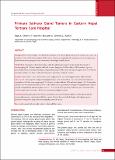Please use this identifier to cite or link to this item:
https://hdl.handle.net/20.500.14356/2009Full metadata record
| DC Field | Value | Language |
|---|---|---|
| dc.contributor.author | Joshi, R R | - |
| dc.contributor.author | Nepal, A | - |
| dc.contributor.author | Chettri, S T | - |
| dc.contributor.author | Bhattarai, M | - |
| dc.contributor.author | Ghimire, A | - |
| dc.contributor.author | Karki, S | - |
| dc.date.accessioned | 2023-06-05T09:15:03Z | - |
| dc.date.available | 2023-06-05T09:15:03Z | - |
| dc.date.issued | 2010 | - |
| dc.identifier.citation | JoshiR. R., NepalA., ChettriS. T., ChettriS. T., BhattaraiM., BhattaraiM., GhimireA., GhimireA., KarkiS., & KarkiS. (2010). Primary Salivary Gland Tumors in Eastern Nepal Tertiary Care Hospital. Journal of Nepal Health Research Council. https://doi.org/10.33314/jnhrc.v0i0.220 | en_US |
| dc.identifier.issn | Print ISSN: 1727-5482; Online ISSN: 1999-6217 | - |
| dc.identifier.uri | http://103.69.126.140:8080/handle/20.500.14356/2009 | - |
| dc.description | Original Article | en_US |
| dc.description.abstract | Abstract Methods: A retrospective observational study of all the salivary gland tumors treated in the department of Otolaryngology, B. P. Koirala Institute of Health Sciences during April 2004 to March 2009 was done. Age, sex, presenting features, radiological findings, histopathological type of the tumor and type of surgery were recorded and descriptive analysis was done to calculate frequencies, percentage and their relations.                       Background: The knowledge of the distribution and pattern of salivary gland tumors in the tertiary care center can provide overview of the disease pattern in the region. It also helps in planning the strategies to treat the disease and launch the awareness program in the community to this largely curable disease. Results: Out of total 51 cases, 81% (n=41) were benign and 19% (n=10) malignant tumors. Male to female ratio was 1:2.1.Mean age for benign and malignant tumors were 32.3 and 46.5 years respectively. Parotid tumor outnumbered all other sites comprising 69%, followed by submandiibular 18% and minor glands 13%. Pleomorphic adenoma was the commonest tumor (76%) of all primary salivary gland tumors. Benign to malignant tumor ratio of parotid, submandibular and minor glands were 6:1,3.5:1 and 1.3:1respectively. Adenoid cystic carcinoma (40%) and mucoepidermoid carcinoma (30%) were commonest malignant tumors. Conclusions: The principal site for salivary gland tumors in eastern Nepal population was the parotid and the pleomorphic adenoma outnumbered all other tumors. Most of the cases in both benign and malignant group presented with painless lump often misleading the gravity of disease.                    Key words: parotid, pleomorphic, salivary, submandibular, tumor | en_US |
| dc.language.iso | en | en_US |
| dc.publisher | Nepal Health Research Council | en_US |
| dc.relation.ispartofseries | April, 2010;220 | - |
| dc.subject | Parotid | en_US |
| dc.subject | Pleomorphic | en_US |
| dc.subject | Salivary | en_US |
| dc.subject | Submandibular, tumor | en_US |
| dc.title | Primary Salivary Gland Tumors in Eastern Nepal Tertiary Care Hospital | en_US |
| dc.type | Journal Article | en_US |
| local.journal.category | Original Article | - |
| Appears in Collections: | Vol 8 No 1 Issue 16 April 2010 | |
Files in This Item:
| File | Description | Size | Format | |
|---|---|---|---|---|
| 220-Article Text-218-1-10-20130822.pdf | Fulltext Download | 326.24 kB | Adobe PDF |  View/Open |
Items in DSpace are protected by copyright, with all rights reserved, unless otherwise indicated.
